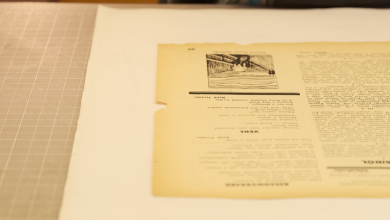When the Heart Belongs to Carhartt

For more than 14 months, Gary Ely has quietly shown up for a job he no longer has at Caplan’s Army Store in St. Johnsbury, Vt.
Caplan’s, a work wear outpost in the heart of town, long enjoyed a loyal base of blue-collar customers, including maple sugarers, railroad workers and grain millers. The store was owned by the same family through multiple generations. Dave Caplan, the most recent owner, moved away from military surplus and introduced more work wear and outdoor gear, for camping, fishing and hunting.
It had weathered the town’s economic challenges, but it couldn’t contend with the pandemic, which crashed the local economy, disrupted the supply chain and forced more commerce online. The store closed just shy of its 100th birthday, on Dec. 31, 2020.
Many residents mourned Caplan’s passing as if they had lost a close relative.
“I miss Gary and everybody else who was working there since before I was born,” said Blake Schoolcraft, the son of a local carpenter. “I miss the atmosphere — the claustrophobic aisles with puffy coats bumping into you and the creaky wood floors.”
Mr. Schoolcraft, 29, makes a solid living as a builder, but most major employers have fled this mythical region, known as the Northeast Kingdom, whose counties are now the most impoverished in the state.
Mr. Ely, 84, was hired as Caplan’s in-house tailor when he was 16. In the nearly 70 years he worked there, he altered thousands of trousers for bodies of every shape and size. One gentleman, he recalled, had “a 60-inch waist and 19-and-a-half inch legs!”

Credit…Tristan Spinski for The New York Times
Two days after Caplan’s closed, he returned to the store, where he has continued to show up nearly every morning since, though the aisles remain empty. On a chilly weekday last fall, I returned home, to the Kingdom, where I grew up, and visited Mr. Ely in the empty store, where he listened to a transistor radio and reminisced with the occasional passer-by. When the phone rang, he still answered it, often breaking to callers the sad news of Caplan’s demise.
Mr. Ely said the two pillars in his life have been church and Caplan’s: “It was kind of like a love affair, a good marriage, and all of a sudden, it’s gone.”
What happens to work wear when a country works less?
My relationship to Caplan’s was not as straightforward as Mr. Ely’s, though I too loved its ambience and everything it represented: hard work, masculinity, community. Its walls were replete with photos of bagged buck, moose and bear — there was even a rendering of a mythical bleary-eyed jackalope mounted behind the cash register.
As a teenager, I once bought some crisp Carhartt pants there, hoping they’d confer an aura of toughness and a strong work ethic. My fresh new look didn’t pass muster with the sons of farmers, plumbers and roofers who knew my parents as the hippies who started Catamount Arts, a cultural hub in St. Johnsbury. Hoping to fit in, I rubbed my Carhartt pants in our dirt driveway.
I earned some credibility after spending summers working on houses with Mr. Schoolcraft, his father and a part-time hog farmer named Denny. I learned how to lay shingles, hammer nails and stain wood. Only then, I reasoned, did my distressed, paint-stained pants reveal some truth in my labor.
Mr. Schoolcraft and I weren’t the only ones buying up the Carhartt stock at Caplan’s. As Mr. Ely told me, it always sold the best.
Founded more than 130 years ago as an unpretentious overalls manufacturer, Carhartt has become a brand beloved by folk artists and rappers, oil riggers, skaters and the fashion week crowd. All of its constituents appreciate its high quality and signature canvas: thick duck fabric. It also holds a strong if intangible allure as a romanticized emblem of the humble, flinty American worker.
But as millions of jobs that require steel-toed boots and well-built overalls have moved overseas, younger workers are largely averse to traditional trades, leaving these types of jobs unfilled. Carhartt, meanwhile, has adapted to these new dynamics. Its stores often pop up in urban and suburban areas. Just as Patagonia sells rock-climbing jackets to bankers, Carhartt now sells logging pants to baristas.
And while these new customers endure jokes and memes mocking their clean-cut personas, the politics of wearing (or not wearing) Carhartt seem to be more muddled. Heated dialogue recently erupted after the company decided to enforce President Biden’s vaccine mandate despite a Supreme Court ruling that it was unconstitutional. The move spurred conservative talk of a boycott, while arousing liberal defenders. Somehow, though, Carhartt has succeeded in appealing to its blue-collar emblems, like Sarah Palin, while appealing to new fans, like Barack Obama.
“We don’t look for differences, we look for common values,” said Janet Ries, the vice president of marketing at Carhartt. “That’s how we’ve been able to cast a durable net.” The company still makes plenty of rugged work wear, but it is also expanding its designs to appeal to new buyers, like women and millennials.
But a new mind-set yearns for an old world, where work was tangible and tough. “You feel like you’ve amounted to something when you put in a set of stairs,” Mr. Schoolcraft said. Nathan Colpitts, 33, a blacksmith living off the grid, with no cellphone service and solar energy for power, eight miles from Caplan’s, said that people want to feel “more connected” to things they create. “There’s been a backlash to the virtuality of the world we live in,” he said.
Carhartt devotees have always appreciated how the clothes wear, soften and shape over time. “When you get a new pair of riveted double-knees they can pretty much stand up on their own because they’re so stiff,” Mr. Schoolcraft said. “You have to work in them to make them fit well.”
Travis Samuels, 30, wears a pair of Carhartt overalls as he works to reopen St. Johnsbury’s abandoned grain mill as a hemp processor. Dylan Kempton, a 30-year-old farmer, relies on the pants to keep him warm when he’s milking on below-zero mornings. Mr. Colpitts still owns the pants he wore the day he was accidentally shot in the leg during a botched pig slaughter.
With hipsters taking to handmade culture, many have adopted Carhartt. It may be true that the brand’s newfound popularity in coastal cities, like New York, where I live now, is a form of cultural appropriation, one that surely sands down the struggles of blue-collar life. But the proliferation of these clothes among new types of workers may also reflect the country’s growing sense of precarity, and also solidarity, around labor.
I still feel a twinge of impostor syndrome in Carhartt garments, a sentiment echoed by others I spoke to. But I now see the clothes as representative of where I grew up, my friends and my hard, if often nonphysical, work. And while Carhartt patches may look out of place in the city, fans in New York I spoke with expressed thoughts on work and style that overlapped with my friends up north.
One was Nigel Lord, 44, a hardwood floor specialist, as zealous for the brand as I am. “I don’t even have on the Carhartt jeans today,” he said, “but everything else, bro, all day Carhartt — even to the headband!” Mr. Lord then took off his shoe to reveal a Carhartt sock. A second later, I kicked off my boot to show him that we matched.
Carhartt has pivoted before.
In 1889, in a Detroit loft, Hamilton Carhartt manufactured overalls with two sewing machines and five employees for railroad workers, some of whom offered design input. Carhartt offeredgenerous benefits, and a concept that was innovative at the time: the 40-hour workweek. In 1921, The San Francisco Chronicle marveled that Carhartt workers earned “twice as much as the average paid college professor and nearly three times as much as many of our ministers of the gospel.”
The Great Depression forced most Carhartt plants to close, and nearly drove the company into bankruptcy, but it pivoted, starting its “Back to the Land” campaign, which focused on bringing production out of urban centers and into the rural South. In 1932, Carhartt built a plant in Irvine, Ky., one of the most impoverished places in America at the time.
Carhartt’s Depression-era investments in the South yielded new customers, namely ranchers and farmers. Another loyal constituency was born in the 1970s, when workers on the Alaskan oil pipeline took to the clothing. The Alaska State Fair today features a Carhartt fashion show, as well as a “Crusty Carhartt Tales” competition, during which contestants brag about the “nasty beating” their garments have endured.
The company now has more than 5,500 employees around the world and sells about four million of its knit hats — its most ubiquitous product — each year.




Carharrt work wear worn by St. Johnsbury residents include, clockwise from top left, Nathan Colpitts’s Carhartt pants; Phoebe Weisenfield’s coveralls; Ms. Weisenfield’s jacket; Travis Samuels’s coveralls.Credit…Tristan Spinski for The New York Times
While Carhartt today produces much of its clothing in Mexico, four of its plants remain in Kentucky and Tennessee, employing some of America’s last unionized textile workers. Many were furloughed during the early weeks of the pandemic, but the company maintained their health benefits and supplemented unemployment checks.
Fashion loves Carhartt, too.
Nearly 300 miles south of St. Johnsbury, Carhartt’s Work-in-Progress line hangs sparsely in a high-end boutique, which is scheduled to expand, in the SoHo district of Manhattan. Formed in 1994 through a licensing deal with the Swiss denim designer Edwin Faeh, Work-in-Progress targets disaffected youth, skateboarders and other street dwellers.
When Mr. Faeh discovered Carhartt at a Parisian flea market, he felt that duck canvas was the next denim. Later, in the late 1980s, while visiting Vermont with his wife to scope out promising American styles, he looked up Carhartt in a phone book, called the company on a whim and secured an appointment. The next day, he made the long drive to the Detroit headquarters. There, he pitched, and soon after secured, a European distribution deal, a move that laid the groundwork for Mr. Faeh to license the logo for a street wear offshoot.
It happened to be good timing. Carhartt had just finished a line of 800 customized jackets for Tommy Boy Records, and executives were becoming aware of the brand’s expanding customer base. Alex Guerrero, the global product chief of Carhartt, said Mr. Faeh’s line allowed the company to protect its heritage and expand its customer base, all without having to directly “stretch themselves into fashion.”
Work-in-Progress leaders frequently consult with the American mother ship, and use a version of Carhartt’s triple-stitching technique. But Mr. Faeh commissions different designers and suppliers, and sells to a wealthier clientele. (A brown Carhartt vest I bought at Caplan’s for less than $70 goes for more than twice that amount in SoHo.) In 2018, the company collaborated with the fashion designer Heron Preston on, among other things, a ragged, paint-stained chore jacket priced at $958. A high-concept work wear show by the Japanese designer Junya Watanabe in 2017 featured a tailored Carhartt suit.
‘Women work just as hard as men.’
My friends back home are too busy keeping Vermont’s back-to-the-land traditions alive to fret over Carhartt’s wealthier demographics.
While Work-in-Progress clothes are designed for the streets, the design team for the traditional brand frequently visits job sites like wind farms and logging trails. They also send prototype gear to what’s called “the crew”: a group of 3,000 ranchers, electricians, plumbers and other tradespeople. Ms. Ries, the Carhartt marketing executive, who previously worked at Reebok, compared this feedback process to how athletic brands test their clothing. “Except it’s not a two-hour workout,” she said. “It’s a 10-hour workday.”
The brand has also expanded in other directions.
Phoebe Weisenfield, 32, farms vegetables at the edge of a brook I swam in as a kid. She got her first pair of Carhartts, made for men, once she began fencing cows, in high school. “They never really fit right,” she said. “But I made them work.”
When Mr. Guerrero arrived at Carhartt seven years ago, he discovered that the company had previously tried to connect with women, and failed. “We went down the standard route,” he said. “To shrink and pink the men’s line.”
Just as Hamilton Carhartt had solicited feedback from male railroad workers, Mr. Guerrero and his team started listening to tradeswomen. They included stable workers, who said they liked the comfort of leggings but routinely watched theirs rip and get covered in horsehair. “They were giving up durability for comfort,” he said. “We found a nylon fabric that could endure.”
Ms. Weisenfield appreciates the company’s newer line of women’s work wear, which happens to be its fastest-growing, according to the company. She said these new clothes are comfortable, withstand every season and also make clear an important fact: “Women work just as hard as men.”
Seeing the future.
Some St. Johnsbury citizens rallied to revive Caplan’s, including Robin Little, a local retailer who explored getting a loan through the Small Business Administration. Her efforts, and those of others, ultimately failed.
Mr. Schoolcraft makes decent money but has seen the physical toll that his father’s job took on his body, and already sees his own body showing signs of wear and tear. He’s got an eye on an exit, even as he’s torn up about it.
Mr. Samuels is working around the clock to make sure his hemp processor takes off, part of a recent surge in imaginative ventures by young people in the area. Fledgling entrepreneurs have opened several stores, as well as a craft brewery and distillery. The long-decrepit apartment building in town, once a hotel for railroad workers, will soon reopen as a renovated housing complex that will include low-income residents.
These innovators are betting on a shaky regional economy, one where businesses often blossom, then bust. Vermont’s broader economy is shuddering through change, with its signature dairy farms closing at startling rates. A report released last year said that the number of dairy farms in the state had decreased 84 percent since 1969.
Mr. Kempton, the local farmer, belongs to a family known throughout the area for smart practices that kept them going long past other farms. Still, he recently sold off 300 cows because of the volatile milk market, one that big corporate dairy operations can weather much more easily. “It does seem like it’s getting harder and harder for the working man,” Mr. Kempton said. “Everything is going up, except for wages.”
As for Mr. Ely, he’s not sure where St. Johnsbury residents will get their Carhartt these days, but he still hems pants at home for a few old customers. When Caplan’s threw a big sale to empty the store, he said he was saddest to see the old wooden tailor sign sold off for $75. “I would have put it up in the house,” he said. “That’s the only reason to have kept it, as a keepsake of a place you spent a lot of time, a place you’ve become a part of.”




